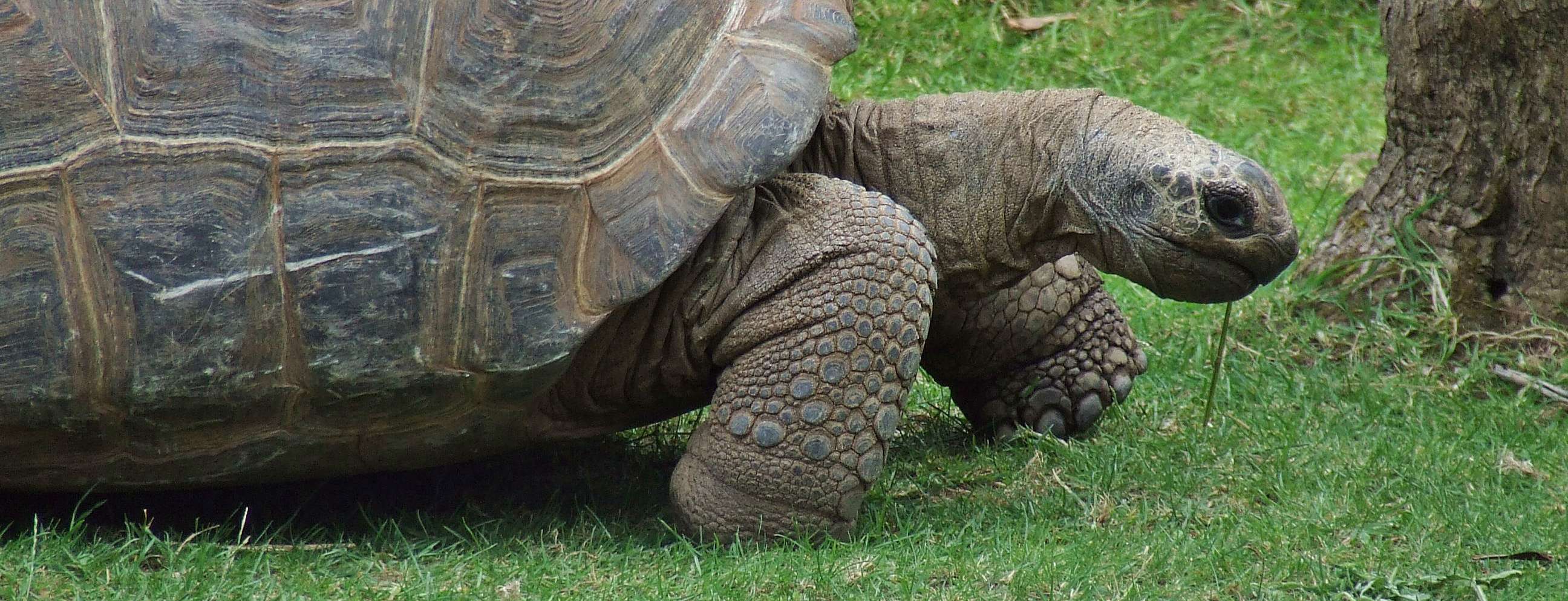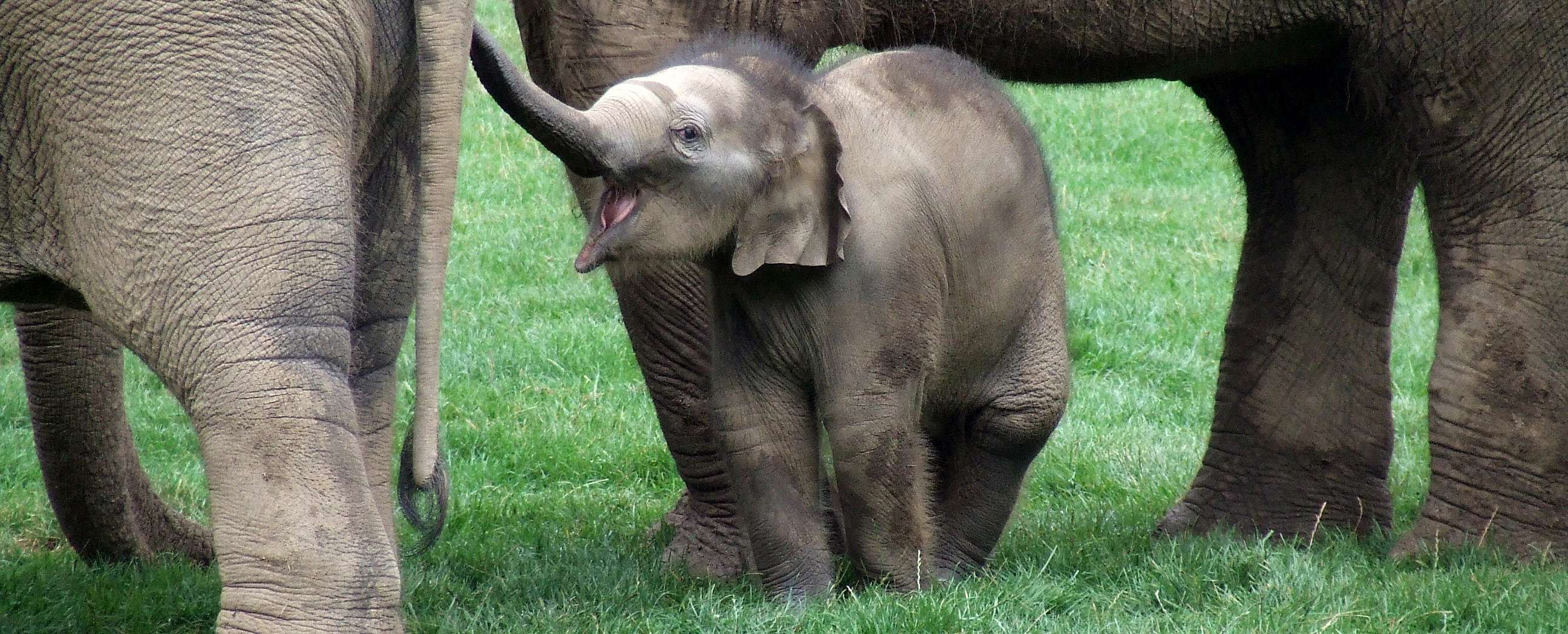Európa állatkertjei
ZOOlogical Gardens of EuROPE

MIXED-SPECIES EXHIBITS WITH CARNIVORANS III.
Mixed-species exhibits with Cats (Felidae) and Hyenas (Hyaenidae)
Written by KRISZTIÁN SVÁBIK
Assistant Curator, Budapest Zoo and Botanical Garden, Hungary
Uploaded: 8th June 2018
Refreshed: 18th May 2020
INTRODUCTION
Within the narrower meaning of the mixed-species exhibits this document deals with nine species of cats and one species of hyenas.
In the list below you can see which species have been kept in mixed exhibits in captivity:
Cats, Felidae
Lion, Panthera leo Linnaeus, 1758
Tiger, Panthera tigris Linnaeus, 1758
Cheetah, Acinonyx jubatus Schreber, 1775
Serval, Leptailurus serval Schreber, 1776
Eurasian Lynx, Lynx lynx Linnaeus, 1758
Caracal, Caracal caracal Schreber, 1776
Puma, Puma concolor Linnaeus, 1771
Margay, Leopardus wiedii Schinz, 1821
Leopard Cat, Prionailurus bengalensis Kerr, 1792
Hyenas, Hyaenidae
Aardwolf, Proteles cristata Sparrman, 1783
Furthermore – before discussing the main topic – it is worth to mention the socialization with pets as a dog (Canis familiaris) and domestic cat (Felis catus), as well as the cohabitation of different cat species.
Dog and cat as companion
Despite being large predators who are able to move at seriously exceedingly speeds, Cheetahs are actually surprisingly shy. These cats are often so nervous and anxious in captivity which reduces the breeding success designed to the species in zoos. That's where dogs come in. Across the United States, zoos including the San Diego Zoo Safari Park, Columbus Zoo, Dallas Zoo and Wildlife Safari have been pairing Cheetahs with their own canine companions in favour of mental and physical wellbeing of the cats which seems to work. When Cheetah cubs are a few months old, they first get to meet their new best friends through a fence, then on leashes if they get along well. Once keepers are confident that they will be fine together, the Cheetah and dog are often brought to a shared living space inside the zoo where they can play off-leash and reach full running speeds chasing each other around. These exercise sessions provide the cats with the opportunity to thrive by expressing natural behaviors like sprinting and chasing. This is also an opportunity to help build the muscles and fitness, which will allow them to reach their running potential.
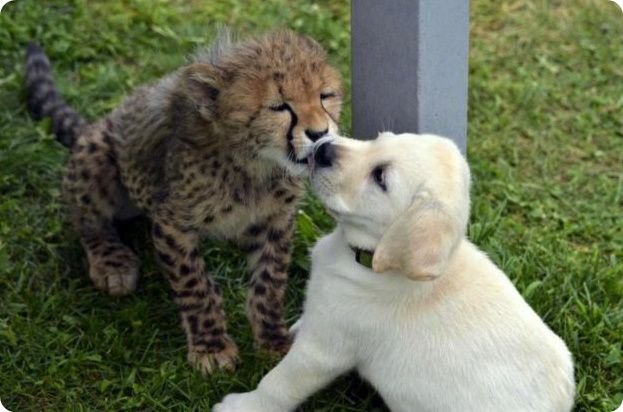
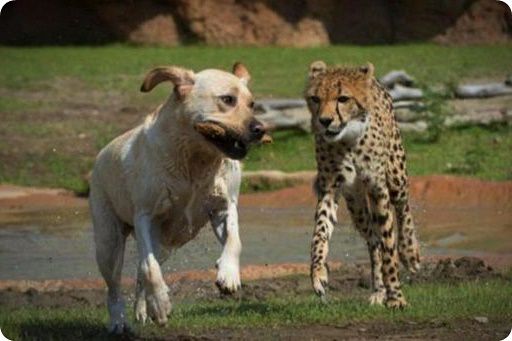
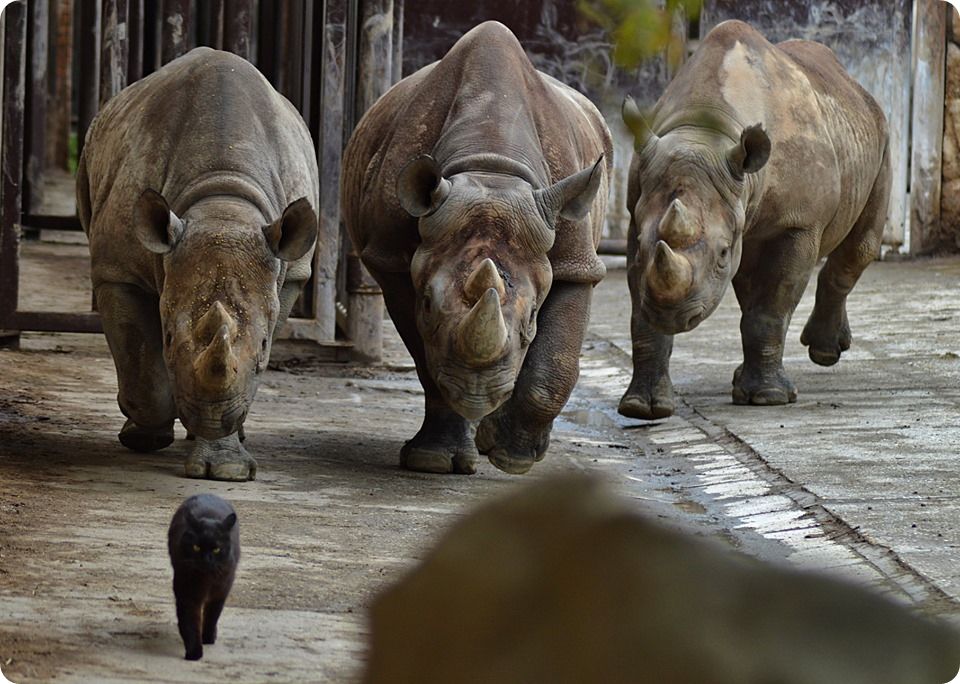
Above: Cheetah and labrador
San Diego Zoo Safari Park, California, United States of America
Photo © Andy Stardust
Below: a spontaneous and temporary "mixed exhibit" with domestic cat and Eastern Black Rhinoceroses (Diceros bicornis michaeli)
ZOO Dvůr Králové, Czech Republic
Photo © Kateřina Lochovská
Coexistences with domestic cats were also reported from some institution – for example Rostov Zoo with Western Lowland Gorilla (Gorilla gorilla gorilla) and ZooTampa Lowry Park with Bornean Orangutan (Pongo pygmaeus) (HAMMER 2002) – which were mostly spontaneous and did not have such a conscious scientific background as mentioned beforehand.
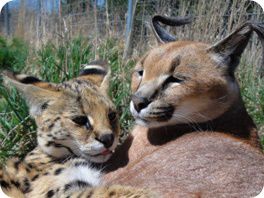 Cats with cats
Cats with cats
In case of both big cats and small cats species have been kept together on several occasions, which is less often taken place in zoos but much more often in private collections, sanctuaries and in rescue centers. In several cases it results hybrids which does not belong to the main subject of this document so I do not deal with the question in detail. As may be seen below on the lists of the species combinations and mixed-species exhibits I will not indicate the associations where different cat species have been kept together, although some typical examples are also given here:
Tiger, Lion and their hybrids – Greater Wynnewood Exotic Animal Park (Oklahoma, United States of America)
Tiger, Lion and Leopard – Out of Africa Wildlife Park (Camp Verde, Arizona, United States of America)
Serval, Caracal – Cedar Cove Feline Conservatory & Sanctuary (Kansas, United States of America) and The Wildcat Sanctuary (Sandstone, Minnesota, United States of America)
Serval, Bobcat – Austin Zoo (Texas, United States of America)
Bobcat, Eurasian Lynx – Keepers of the Wild Nature Park (Valentine, Arizona, United States of America)
Bobcat, Canadian Lynx – Wildwood Zoo (Marshfield, Wisconsin, United States of America)
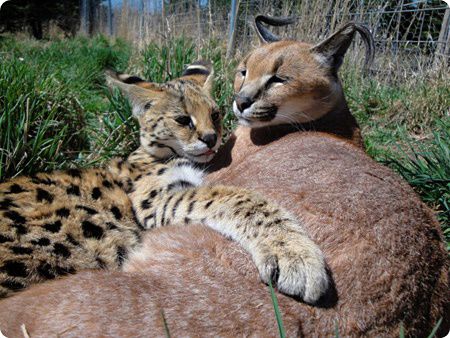
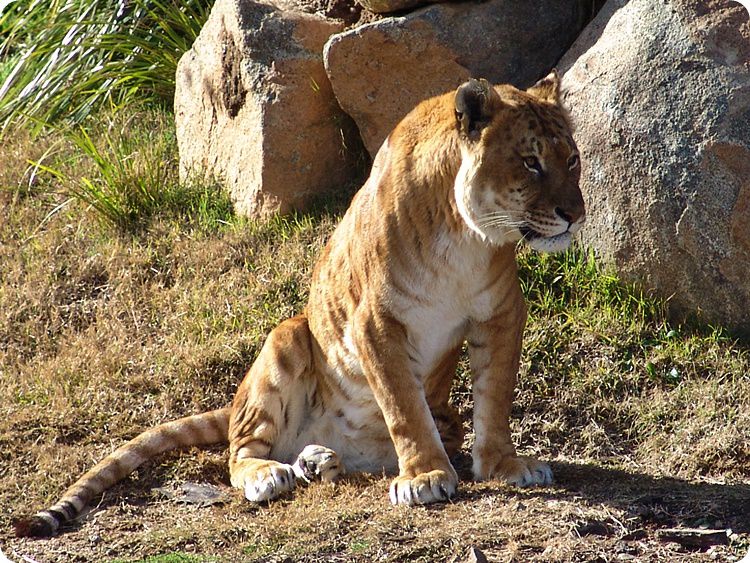
Left: Serval (Leptailurus serval) and Caracal (Caracal caracal)
The Wildcat Sanctuary, Sandstone, Minnesota, United States of America
Photo © The Wildcat Sanctuary
Right: Tigon (Panthera tigris x Panthera leo), Panthera hybrid of a male Tiger and female Lion
National Zoo & Aquarium, Canberra, Australia
Photo © Bentley Smith
LIST OF SPECIES COMBINATIONS - FELIDAE
The list shows examples of species combinations with at least one felid species combined with the taxa below (without mentioning different felid species have been kept together)
Lion, Panthera leo (Photo © Krisztián Svábik)
Tiger, Panthera tigris
Meerkat, Suricata suricatta
Yellow Mongoose, Cynictis penicillata
Black-backed Jackal, Canis mesomelas
Brown Bear, Ursus arctos
American Black Bear, Ursus americanus
Asian Small-clawed Otter, Aonyx cinerea
Alexandrine Parakeet, Psittacula eupatria
Tiger, Panthera tigris (Photo © Krisztián Svábik)
Lion, Panthera leo
American Black Bear, Ursus americanus
Cheetah, Acinonyx jubatus (Photo © Krisztián Svábik)
Patas Monkey, Erythrocebus patas
White Rhinoceros, Ceratotherium simum
Black Rhinoceros, Diceros bicornis
Plains Zebra, Equus quagga
Pygmy Hippopotamus, Choeropsis liberiensis
Ankole-Watusi Cattle, Bos primigenius f. taurus
Common Eland, Taurotragus oryx
Giraffe, Giraffa camelopardalis
Galapagos Tortoise, Chelonoidis nigra
African Spurred Tortoise, Centrochelys sulcata
Serval, Leptailurus serval (Photo © Krisztián Svábik)
Nicobar Crab-eating Macaque, Macaca fascicularis
Dwarf Donkey, Equus asinus
Pygmy Hippopotamus, Choeropsis liberiensis
Walliser Blacknecked Goat, Capra aegagrus f. hircus
Dwarf Zebu, Bos primigenius f. taurus
Common Eland, Taurotragus oryx
Eurasian Lynx, Lynx lynx (Photo © Krisztián Svábik)
Brown Bear, Ursus arctos
Caracal, Caracal caracal (Photo © Krisztián Svábik)
Indian Crested Porcupine, Hystrix indica
Puma, Puma concolor (Photo © Tamás Boros)
Grey Wolf, Canis lupus
American Black Bear, Ursus americanus
Margay, Leopardus wiedii (Photo © Krisztián Svábik)
Geoffroy's Toadhead Turtle, Phrynops geoffroanus
 Leopard Cat, Prionailurus bengalensis (Photo © Bernard Dupont)
Leopard Cat, Prionailurus bengalensis (Photo © Bernard Dupont)
Asiatic Brush-tailed Porcupine, Atherurus macrourus
Malayan Porcupine, Hystrix brachyura
Binturong, Arctictis binturong
Common Palm Civet, Paradoxurus hermaphroditus
Indian Muntjac, Muntiacus muntjak
LIST OF SPECIES COMBINATIONS - HYAENIDAE
The list shows examples of species combinations with at least one hyena species combined with the taxa below
Aardwolf, Proteles cristata (Photo © Tamás Boros)
Aardvark, Orycteropus afer
Rock Hyrax, Procavia capensis
Wolf's Mona Monkey, Cercopithecus wolfi
Eastern Black-and-white Colobus, Colobus guereza kikuyuensis
King Colobus, Colobus polykomos
Spring Hare, Pedetes capensis
Cape Porcupine, Hystrix africaeaustralis
Crested Porcupine, Hystrix cristata
Meerkat, Suricata suricatta
Tawny Frogmouth, Podargus strigoides
Pearl-spotted Owlet, Glaucidium perlatum
LIST OF MIXED-SPECIES EXHIBITS WITH LOCATIONS - FELIDAE
The list shows specific examples of mixed-species exhibits involving at least one felid species combined with the taxa below, with indication of the institution(s) where they have been tried out (without mentioning different felid species have been kept together)
Lion, Panthera leo
Combined species:
- Lion, Panthera leo
- Meerkat, Suricata suricatta
Institution(s): Colchester Zoo (United Kingdom)
Combined species:
- Lion, Panthera leo
- Yellow Mongoose, Cynictis penicillata
Institution(s): Zoo Basel (Switzerland), ZOO Antwerpen (Belgium)
Combined species:
- Lion, Panthera leo
- Meerkat, Suricata suricatta
- Yellow Mongoose, Cynictis penicillata
Institution(s): Zoologischer Garten Schwerin (Germany)
Combined species:
- Lion, Panthera leo
- Black-backed Jackal, Canis mesomelas
Institution(s): Zoo Leipzig (Germany)
Combined species:
- Lion, Panthera leo
- Tiger, Panthera tigris
- American Black Bear, Ursus americanus
Institution(s): Noah’s Ark Animal Sanctuary (Locust Grove, Georgia, United States of America )
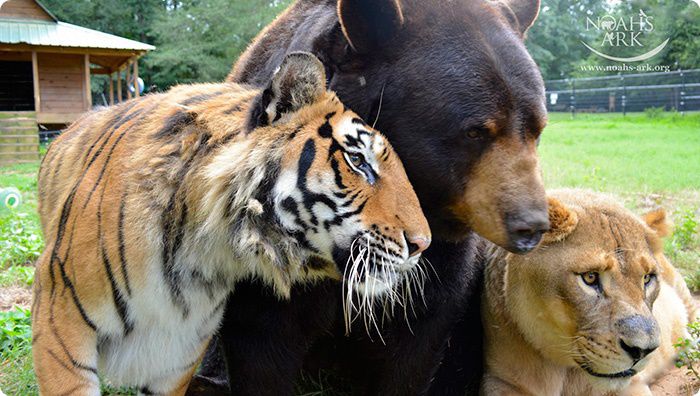
Tiger (Panthera tigris), American Black Bear (Ursus americanus) and Lion (Panthera leo)
Noah’s Ark Animal Sanctuary, Locust Grove, Georgia, United States of America
Photo © Noah’s Ark Animal Sanctuary
Combined species:
- Lion, Panthera leo
- Brown Bear, Ursus arctos
Institution(s): Shenyang Forest Wild Zoological Garden (China)
Combined species:
- Lion, Panthera leo
- Asiatic Black Bear, Ursus thibetanus
Institution(s): Khao Kheow Forest & Wildlife Park (Chon Buri, Thailand)
Combined species:
- Lion, Panthera leo persica
- Asian Small-clawed Otter, Aonyx cinerea
Institution(s): Zoo Zürich (Switzerland)
Combined species:
- Lion, Panthera leo
- Alexandrine Parakeet, Psittacula eupatria
unknown institution
Tiger, Panthera tigris
Combined species:
- Tiger, Panthera tigris
- Lion, Panthera leo
- American Black Bear, Ursus americanus
Institution(s): Noah’s Ark Animal Sanctuary (Locust Grove, Georgia, United States of America)
Cheetah, Acinonyx jubatus
Combined species:
- Cheetah, Acinonyx jubatus
- Patas Monkey, Erythrocebus patas
Institution(s): Zoo Leipzig (Germany)
Combined species:
- Cheetah, Acinonyx jubatus
- White Rhinoceros, Ceratotherium simum
Institution(s): Borås Djurpark (Sweden), Zoo & Aquazoo Schmiding (Krenglbach, Austria), Attica Zoological Park (Athens, Greece), Flamingo Land Resort (Kirby Misperton, United Kingdom), Cleveland Metroparks Zoo (Ohio, United States of America), Parc Safari (Quebec, Canada), Everland - Zootopia (Jongin, South Korea)
South African Cheetahs (Acinonyx jubatus jubatus) and Southern White Rhinoceroses (Ceratotherium simum simum)
Attica Zoological Park, Athens, Greece
Photos © Attica Zoological Park
South African Cheetah (Acinonyx jubatus jubatus) and Southern White Rhinoceroses (Ceratotherium simum simum)
Attica Zoological Park, Athens, Greece
Photo © Nayer Youakim
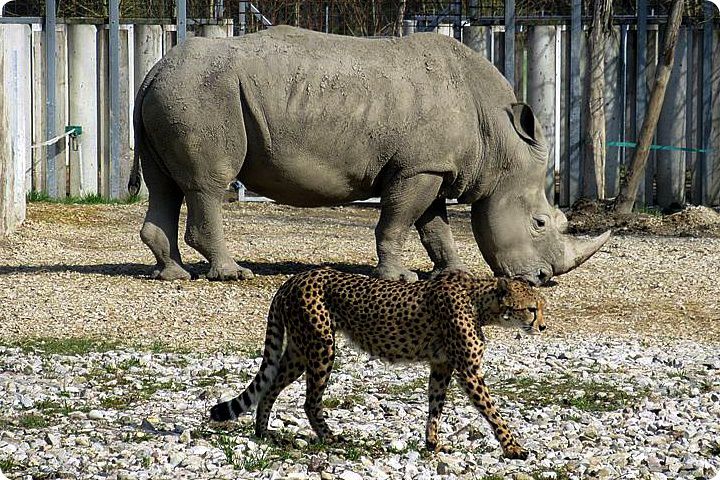
South African Cheetah (Acinonyx jubatus jubatus) and Southern White Rhinoceros (Ceratotherium simum simum)
Zoo & Aquazoo Schmiding, Krenglbach, Austria
Photo © Jola Belik
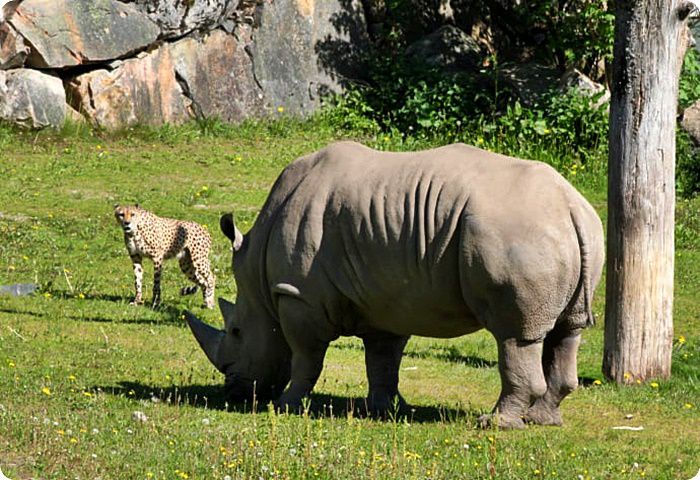
South African Cheetah (Acinonyx jubatus jubatus) and Southern White Rhinoceros (Ceratotherium simum simum)
Borås Djurpark, Sweden
Photo © Bo Kjellson
Cheetahs (Acinonyx jubatus) and Southern White Rhinoceros (Ceratotherium simum simum)
Everland – Zootopia, Jongin, South Korea
Photo © Alex Kantorovich
Combined species:
- Cheetah, Acinonyx jubatus
- Black Rhinoceros, Diceros bicornis
Institution(s): Zoo Leipzig (Germany), Port Lympne Wild Animal Park (United Kingdom)
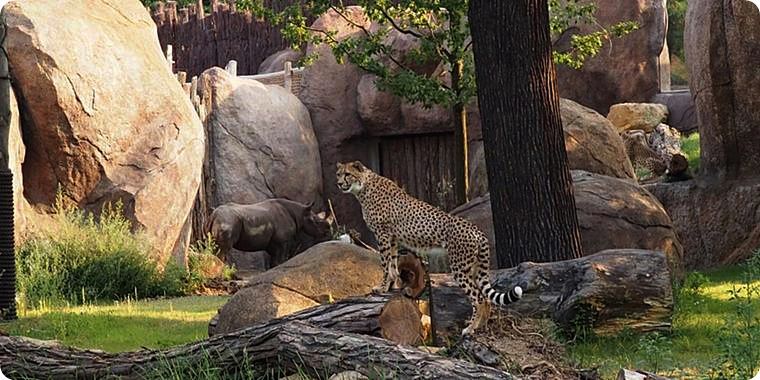
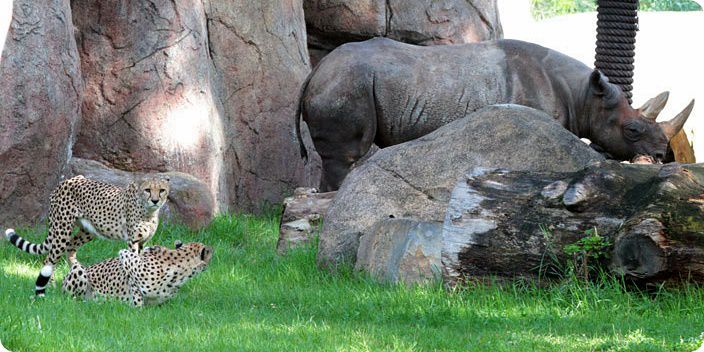
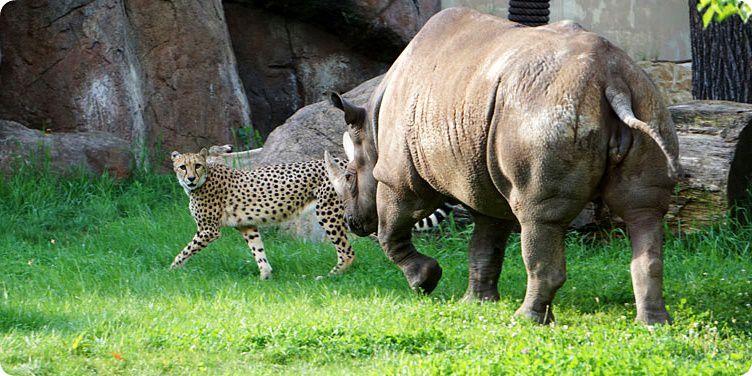
South African Cheetahs (Acinonyx jubatus jubatus) and Eastern Black Rhinoceros (Diceros bicornis michaeli)
Zoo Leipzig, Germany
Photos © Zoo Leipzig
Combined species:
- Cheetah, Acinonyx jubatus
- Plains Zebra, Equus quagga
Institution(s): African Safari (Oita, Japan)
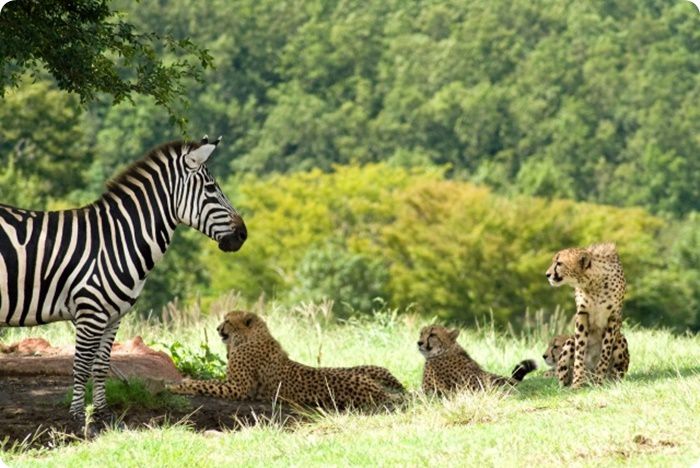
Cheetahs (Acinonyx jubatus) and Plains Zebra (Equus quagga)
African Safari, Oita, Japan
Photo © African Safari
Combined species:
- Cheetah, Acinonyx jubatus
- Pygmy Hippopotamus, Choeropsis liberiensis
Institution(s): Safari World (Bangkok, Thailand)
Combined species:
- Cheetah, Acinonyx jubatus
- Ankole-Watusi Cattle, Bos primigenius f. taurus
Institution(s): Safaripark Pombia (Italy)
Combined species:
- Cheetah, Acinonyx jubatus
- Plains Zebra, Equus guagga
- Common Eland, Taurotragus oryx
- Giraffe, Giraffa camelopardalis
Institution(s): Zoorasia – Yokohama Zoological Gardens (Japan)
South African Cheetah (Acinonyx jubatus jubatus) and Grant’s Zebras (Equus quagga boehmi)
Zoorasia – Yokohama Zoological Gardens, Japan
Photo © Nayer Youakim
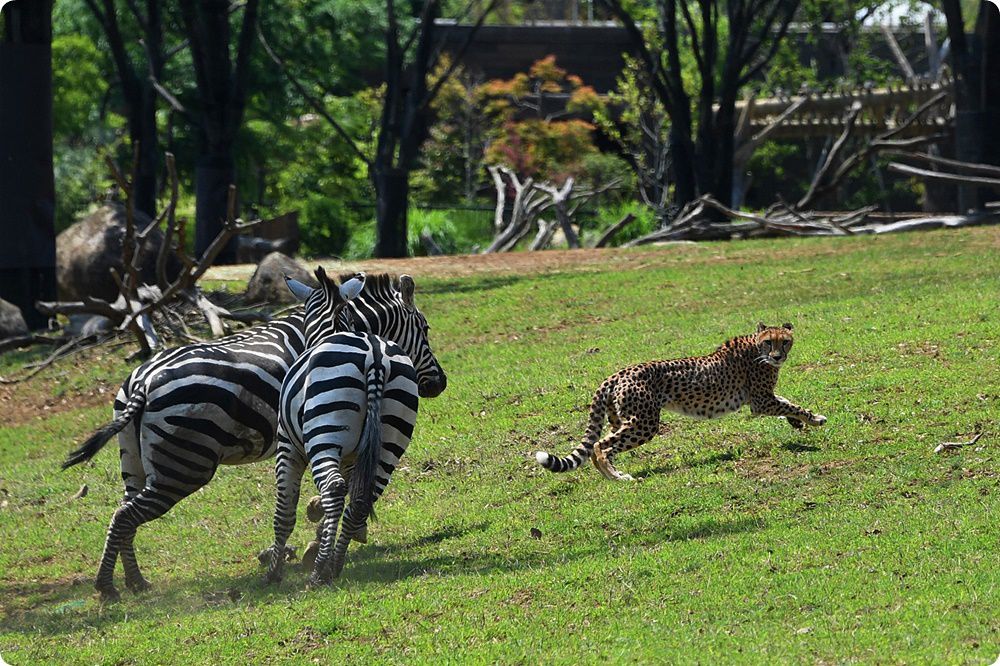
Grant’s Zebras (Equus quagga boehmi) chase away a South African Cheetah (Acinonyx jubatus jubatus)
Zoorasia – Yokohama Zoological Gardens, Japan
Photo © Zoorasia – Yokohama Zoological Gardens
South African Cheetah (Acinonyx jubatus jubatus) and Grant’s Zebra (Equus quagga boehmi)
Zoorasia – Yokohama Zoological Gardens, Japan
Photo © Zoorasia – Yokohama Zoological Gardens
South African Cheetah (Acinonyx jubatus jubatus) and Eland (Taurotragus oryx)
Zoorasia – Yokohama Zoological Gardens, Japan
Photo © Zoorasia – Yokohama Zoological Gardens
South African Cheetah (Acinonyx jubatus jubatus), Grant’s Zebra (Equus quagga boehmi) and Eland (Taurotragus oryx)
Zoorasia – Yokohama Zoological Gardens, Japan
Photo © Nayer Youakim
South African Cheetah (Acinonyx jubatus jubatus), Reticulated Giraffe (Giraffa camelopardalis reticulata) and Elands (Taurotragus oryx)
Zoorasia – Yokohama Zoological Gardens, Japan
Photo © Zoorasia – Yokohama Zoological Gardens

Cheetahs have some „ungulate-free” zones that are walled in by dead trees
Zoorasia – Yokohama Zoological Gardens, Japan
Photo © Zoorasia – Yokohama Zoological Gardens
Their is an adjoining, smaller area where the Cheetahs separated in case the herbivores have offspring
Zoorasia – Yokohama Zoological Gardens, Japan
Photo © Zoorasia – Yokohama Zoological Gardens
Combined species:
- Cheetah, Acinonyx jubatus
- Galapagos Tortoise, Chelonoidis nigra
- African Spurred Tortoise, Centrochelys sulcata
Institution(s): Houston Zoo (Texas, United States of America)
Serval, Leptailurus serval
Combined species:
- Serval, Leptailurus serval
- Pygmy Hippopotamus, Choeropsis liberiensis
Institution(s): Bioparc Fuengirola (Spain)
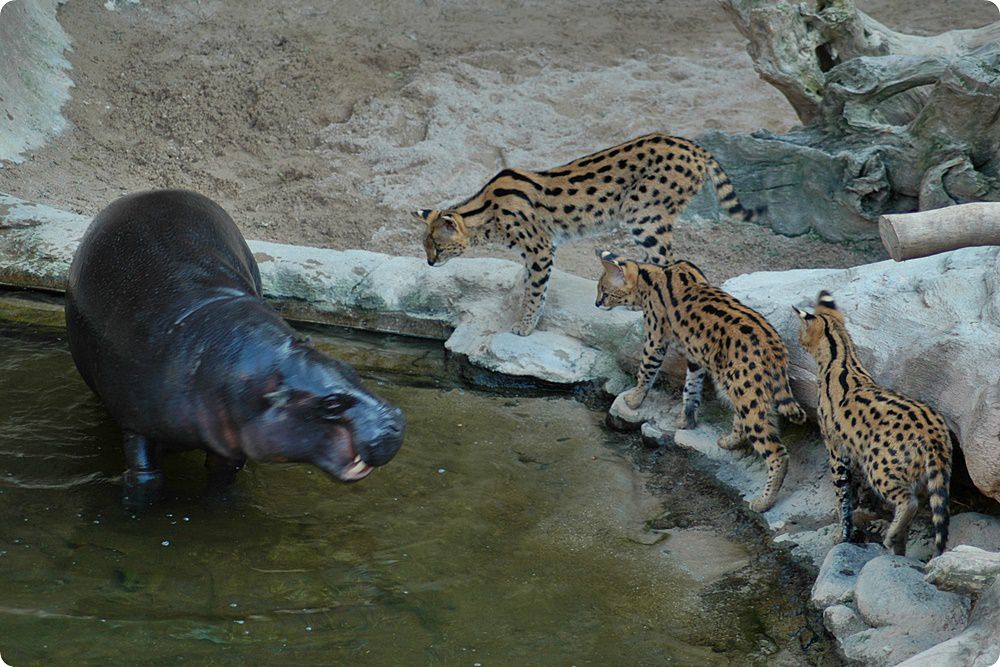
Servals (Leptailurus serval) and Pygmy Hippopotamus (Choeropsis liberiensis)
Bioparc Fuengirola, Spain
Photo © Jonas Livet
Combined species:
- Serval, Leptailurus serval
- Nicobar Crab-eating Macaque, Macaca fascicularis
- Dwarf Donkey, Equus africanus f. asinus
- Walliser Blacknecked Goat, Capra aegagrus f. hircus
- Dwarf Zebu, Bos primigenius f. taurus
- Common Eland, Taurotragus oryx (afterwards, instead of the Dwarf Zebu)
Institution(s): Tierpark Nadermann (Delbrück, Germany)
Eurasian Lynx, Lynx lynx
Combined species:
- Eurasian Lynx, Lyn lynx
- Brown Bear, Ursus arctos
Institution(s): Zoo Salzburg Hellbrunn (Austria)
Caracal, Caracal caracal
Combined species:
- Caracal, Caracal caracal
- Indian Crested Porcupine, Hystrix indica
Institution(s): Al Wabra Wildlife Preservation (Quatar)
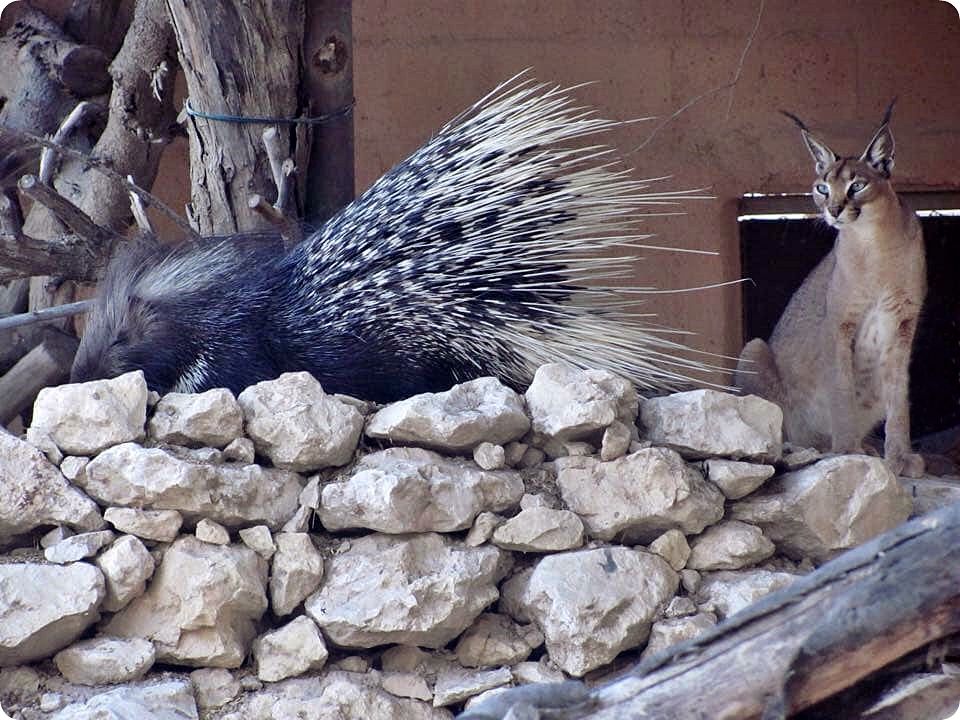
Caracal (Caracal caracal) and Indian Crested Porcupine (Hystrix indica)
Al Wabra Wildlife Preservation, Quatar
Photo © Mario Berndtgen
Cougar, Puma concolor
Combined species:
- Cougar, Puma concolor
- Grey Wolf, Canis lupus
- American Black Bear, Ursus americanus
Institution(s): Out of Africa Wildlife Park (Camp Verde, Arizona, United States of America)
Cougar (Puma concolor) and American Black Bear (Ursus americanus)
Out of Africa Wildlife Park, Camp Verde, Arizona, United States of America
Photo © Out of Africa Wildlife Park
Margay, Leopardus wiedii
Combined species:
- Margay, Leopardus wiedii yucatanicus
- Geoffroy's Toadhead Turtle, Phrynops geoffroanus
Institution(s): Zoo Brno (Czech Republic)
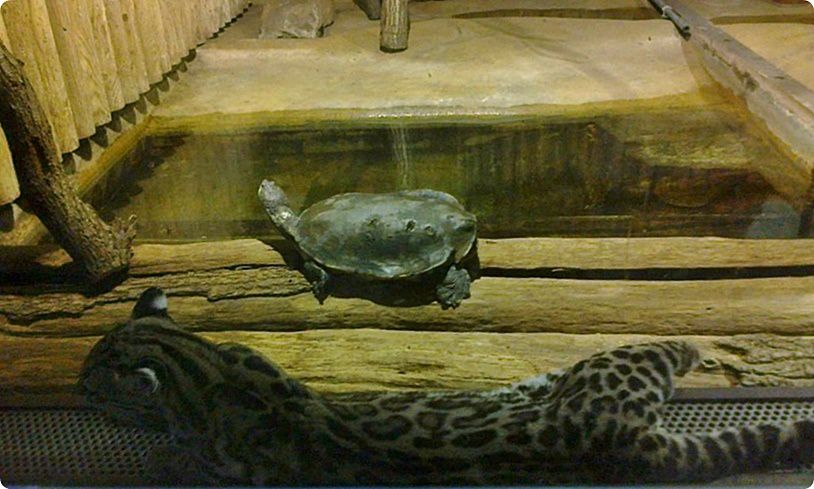
Margay (Leopardus wiedii yucatanicus) and Geoffroy's Toadhead Turtle (Phrynops geoffroanus)
Zoo Brno, Czech Republic
Photo © Dorota Gremlicová
 Leopard Cat, Prionailurus bengalensis
Leopard Cat, Prionailurus bengalensis
Combined species:
- Leopard Cat, Prionailurus bengalensis
- Malayan Porcupine, Hystrix brachyura
- Asiatic Brush-tailed Porcupine, Atherurus macrourus
- Binturong, Arctictis binturong
- Common Palm Civet, Paradoxurus hermaphroditus
- Indian Muntjac, Muntiacus muntjak
Institution(s): Zoo Taiping & Night Safari (Malaysia)
LIST OF MIXED-SPECIES EXHIBITS WITH LOCATIONS - HYAENIDAE
The list shows specific examples of mixed-species exhibits involving at least one hyena species combined with the taxa below, with indication of the institution(s) where they have been tried out
Aardwolf, Proteles cristata
Combined species:
- Aardwolf, Proteles cristata
- Aardvark, Orycteropus afer
- Tawny Frogmouth, Podargus strigoides
- Pearl-spotted Owlet, Glaucidium perlatum
Institution(s): Zoo Frankfurt (Germany)
Combined species:
- Aardwolf, Proteles cristata
- Rock Hyrax, Procavia capensis
- Eastern Black-and-white Colobus, Colobus guereza kikuyuensis
unknown institution
Combined species:
- Aardwolf, Proteles cristata
- King Colobus, Colobus polykomos
Institution(s): Cincinnati Zoo & Botanical Garden (Ohio, United States of America)
Combined species:
- Aardwolf, Proteles cristata
- Wolf’s Mona Monkey, Cercopithecus wolfi
- Eastern Black-and-white Colobus, Colobus guereza kikuyuensis
Institution(s): San Antonio Zoo (Texas, United States of America)
Combined species:
- Aardwolf, Proteles cristata
- Cape Porcupine, Hystrix africaeaustralis
Institution(s): Brookfield Zoo (Illinois, United States of America)
Combined species:
- Aardwolf, Proteles cristata
- Meerkat, Suricata suricatta
- Crested Porcupine, Hystrix cristata
Institution(s): Phoenix Zoo (Arizona, United States of America)
Combined species:
- Aardwolf, Proteles cristata
- Spring Hare, Pedetes capensis
Institution(s): Brookfield Zoo (Illinois, United States of America)
SUMMARIZE THE EXPERIENCES
This document purposefully focuses on creating a list of mixed-species exhibits with family Felidae and Hyaenidae, for further and detailed information it is worth contacting the institutions mentioned above. Only a short summary of the general experiences is given here. Many of the listed coexistences are still ongoing at present; many of them are not anymore.
Cats
According to several zoos experiences Lion and mongoose cohabitation was not successful. In these cases the smaller species had an enclosure of their own and they have had access to the enclosure of the big cats through tunnels, where many alternative tunnels and exits were hidden. In a coexistence of mongooses and Lions lethal accidents have also been reported during the period of introduction as one of the Lions was able to catch a mongoose at Zoologischer Garten Schwerin and ZOO Antwerpen (HAMMER 2002, PAPIES 2018, pers. comm.). In Schwerin the initial group structure was 1.2 Lion, 1.1 Meerkat, 1.2 Yellow Mongoose, later on the mongooses established a group as they were well breeding. The outdoor enclosure was a 700 m² hilly area with grass and rocks, including an extensive system of underground caves and tubes, comprising 28 exits and mongooses had 12 m² area exclusively for their own. The tube system was extended and the mongooses were habituated to the enclosure for two weeks in absence of lions. During this habituation phase, animals where regularly frightened by several stimuli to improve their anti predator behaviours. Two Yellow Mongooses were preyed upon by lions. With rising numbers of lions present in the outdoor enclosure, mongooses started to become more cryptic lifestyle. Worth mentioning that Yellow Mongooses might prey upon young Meerkats (ZIEGLER 2002). In Zoo Basel Yellow Mongooses were also killed and eaten by Lions (HOUWALD 2018, pers. comm.).
Keeping together Lions and Black-backed Jackals at Zoo Leipzig was also not successful. The initial group structure was 2.1 Lion (genders were kept separately) and 1.1 Black-backed jackals (both juveniles), later on changed to 2.0 Lions. The 1100 m² sized mixed exhibit was covered with grass and artificial kopje-like cliffs and surrounded by dry ditch and water moat, enclosure was partly equipped with hot wires. Association was only outdoor. Jackals were given sufficient time to explore the outdoor enclosure, so habituation happened in absence of Lions. Planted areas between the dry ditch and jackals indoor area exclusively accessible for the jackals (protected against Lions through hot wires). During the first weeks jackals preferred to used the outdoor enclosure during the night. They did not try to dig burrows and accepted sleeping boxes indoor. Since January 2001 jackals showed more diurnal activities in the outdoor enclosure, together with Lions. In February 2001, the female jackal incautiously ignored the distance to the next shelter and was cornered by the male Lions. During this encounter the jackal was lethally injured and subsequently euthanasised. To reduce the risk of further jackal – lion encounters, artificial tubes were integrated into the ground of the outdoor enclosure, but they were not used by the remaining male jackal. About six weeks after the loss of the female, the male jackal was found with multiple bone fractures on the ground of the dry ditch (5 m deep). This lethal accident occurred in the absence of Lions during the night. The curiosity and playful behaviours of the relatively young (approx. 2.5 years of age) male Lions towards new stimuli might be one reason for the failure of this association. Another reason can be seen in the wet and loamy soil of the outdoor enclosure, preventing the jackals to dig a system of protective burrows (ZIEGLER 2002).
The combination of Asiatic Lions and Asian Small-clawed Otters in Zoo Zürich was also stopped as one of the female lions was able to catch the otters. At moment the institution is planning to introduce some bird species into the lion indoor exhibit (LODDENKEMPER 2018, pers. comm.).
A rescued Lion, Tiger and American Black Bear at Noah’s Ark Animal Sanctuary have been living together since their „childhood”.
A standard enclosure – despite of the enrichment programmes – can be soon boring for the Cheetahs. Another species can help a lot, and a relatively calm White Rhinoceros is especially suitable for an association. The big herbivores do not fit into the prey pattern of the cats and mostly ignore the Cheetahs. The Cheetahs are not afraid of them, instead they move quietly and calm between and around the Rhinos (HAMMER 2002).
Cheetah and White Rhinoceros combination are more and more „common” in the zoo community. One of the earliest example of this cohabitation is from Borås, where a 7000 m² enclosure is available for the animals, and the Cheetahs have their own, raised, rhino-free area.
An interesting species combiation has been created in Zoo Leipzig when its „Kiwara-Kopje” exhibit was opened in 2015. The institution tried to keep Black Rhinoceroses together with Cheetahs and Patas Monkeys which was no problem as long as the rhinos have been only together with one of the species.The problem was bring together the cats and monkeys. The zoo knew from the beginning that this could be a problem, so every species had got its own room: rhino-free area for the Cheetahs and some cheetah-free area for the Patas Monkeys. Three major things were observed during the introduction period: the Cheetahs worked together, one hunted and the other one waited and crossed the escape way of the monkey; Patas monkey instinctively love running more than climbing so they never got to save areas; and eventually the leader of the group of Patas Monkeys tried to refract the Cheetahs from the rest of the monkeys. All these points together made it impossible to combine these two species. Fortunately the Cheetahs has never caught one of the monkeys (HOLLAND 2018, pers. comm.).
A more complex association was created in Zooroasia - Yokohama Zoological Gardens when its „Savanna in Africa” area was opened in 2015. The institution has started to mix four species in this exhibit: Cheetahs with Zebras, Elands and Giraffes. This is the first occasion in Japan that exhibits three species of big herbivores with a carnivoran species. The base of the success of this exhibit is taken into account the behaviour of each species: as Cheetahs basically do not kill species that are bigger than themselves, mixing adult speciemens of the herbivores cause no problem. The size of the mixed exhibit is 8200 m² and their is an adjoining, smaller area where the Cheetahs separated in case the herbivores have offspring. During the proper management of this combination the institution need to be careful that Cheetahs have the possibility to keep good distance from the ungulates as Elands and Zebras often chase them away. Therefore the cats have some escape zones that are walled in by dead trees (WATANABE 2018, pers. comm.).
Worth to mention that Zoo Basel plans to introduce Cheetahs to the enclosure will be built for African Elephant bull (HOUWALD 2018, pers. comm.).
A few mixed-species exhibits with Servals were also described. In Tierpark Nadermann a Serval has lived amongst a herd of Walliser Blacknecked Goats and Nicobar Crab-eating Macaques for several years, although those were leading young at the same time. Later on Dwarf Donkeys and Dwarf Zebus, afterwards Common Elands instead of the Zebus has joined to the exhibit. One attack towards an Eland calf by a Serval was also reported.
In one of the exhibits in Bioparc Fuengirola a Serval rotates with Chimpanzees, when the apes are moved to their night holdings, the Serval has access to their exhibit. Also one Pygmy Hippopotamus is shifted to the chimp enclosure at night, so it can be together with the Serval. The exhibit has a very big water area, so when the hippo goes to the land area, the Serval use to climb on the rocks or logs results no problem between the species. Out of the summer months, visitor just can see this combination the 30 minutes before closing the zoo. But the animals use the enclosure till next morning when they are shifted to their holdings for cleaning the enclosure and make it ready for the Chimpanzees (RECUERO 2018, pers. comm.).
A lethal accident happened in Zoo Salzburg Hellbrunn, in a mixed exhibit with Eurasian Lynxes and Brown Bears. One of the two lynxes repeatedly attacked the bear. In one of these attacks the lynx was careless and came into a dead corner of the exhibit from where it was no able to flee from the bear. The other lynx was was stayed undisturbed by the bears. Worth to mention that Wolverines (Gulo gulo), which inhabit the neighbouring enclosure dug themselves through the enclosure for the bears, so sometimes all three species of carnivorans can be observed in the same exhibit (HAMMER 2002).
Another mixed exhibit with cats and bears was taken place in Out of Africa Wildlife Park in Arizona, where two female American Black Bears lived together with two female Cougars for about 17 years without serious incidents. Furthermore, a pack of four young Grey Wolves, two males and two females, lived harmoniously together with the bears and cats for about one year. But as the wolves matured, they became somewhat assertive over one of the Cougars, so the wolves were removed to another habitat. After that the Cougars remained with the bears and currently the ursids are alone (HARRISON, POWELL 2012, pers.comm.).
A cohabitation with Margays and Geoffroy's Toadhead Turtle in Zoo Brno works without problem and it seems enriching for the cats (GREMLICOVÁ 2018, pers. comm.). The species are together only in the indoor enclosure.
Hyenas
For mixed exhibits only the Aardwolf is suitable as the animals feed almost exclusively on termites. Many of the mentioned combinations below – Aardwolf with different primates, Rock Hyrax and Aardvark worked without problems (HAMMER 2002).
Feeding methods and times are crucial which belong to the most important factors in the success of mixed-species exhibits. If possible, the species should be separated for feeding. In case the species can not be fed separately and eat essentially the same type of food, it is necessary to provide enough feeding stations dispersed throughout the exhibit to ensure that each individual obtain a fair amount of food and that competition is kept to a minimum. At the Cincinnati Zoo, consideration of widely different food habits has allowed successful exhibition of a pair of Aardwolves with a troop of King Colobus in a relatively small enclosure. Upon introduction, the male colobus made some threatening signals that lasted several minutes. There was no response from the Aardwolves and after the initial threatening behaviour from the male colobus, both species totally ignored each other (THOMAS & MARUSKA 1996).
In a nocturnal exhibit at Zoo Frankfurt the socialization of Aardwolves and Aardvarks was really successful for a long time. Aardwolves were the submissive species and sometimes showed threat behaviour, but no aggression (HAMMER 2002). Mild stress was also present between the species due to the common use of the underground holes.
At San Antonio Zoo a male Aardwolf has lived together with to primate species just for some time. The Aardwolf was separated over night. Wolf’s Mona Monkeys seemed to bother Aardwolf the most (HAMMER 2002).
ACKNOWLEDGEMENTS
I would like to thank all the persons very much who helped to improve this short summary with providing information and photographs as well, in particulare:
Dorota GREMLICOVÁ curator (Zoo Brno, Czech Republic), Dean HARRISON (Out of Africa Wildlife Park, Camp Verde, Arizona, United States of America), Kevin HODGE general curator (Houston Zoo, Texas, United States of America), Ruben HOLLAND curator (Zoo Leipzig, Germany), Dr. Friederike von HOUWALD curator (Zoo Basel, Switzerland), Jonas LIVET (President, Association Les Zoos dans le Monde, Haguenau, France), Dirk LODDENKEMPER curator (Zoo Zürich, Switzerland), Jesus RECUERO veterinarian/curator (Bioparc Fuengirola, Spain), Matthias PAPIES curator (ZOO Antwerpen, Belgium), Ashton POWELL (Out of Africa Wildlife Park, Camp Verde, Arizona, United States of America), Fabian SCHMIDT curator (Zoo Leipzig, Germany), Hilda TRESZ Behavioral Enrichment & International Animal Welfare coordinator (Phoenix Zoo, Arizona, United States of America), Takeshi WATANABE assistant director (Zoorasia – Yokohama Zoological Gardens, Japan)
As well as I would like to thank all the persons very much who helped to improve this document with providing further photographs, their names are lsited below:
Jola BELIK, Tamás BOROS, Bernard DUPONT, Alex KANTOROVICH, Bo KJELLSON, Jonas LIVET, Kateřina LOCHOVSKÁ, Mario BERNDTGEN, Andy STARDUST, Nayer YOUAKIM
Rerefences:
AMEND, M. 2018. Nachttierhäuser in Zoologischen Gärten. Arbeitsplatz Zoo Sonderausgabe. Berufsverband der Zootierpfleger e. V., Druckerei & Verlag Fabian Hille, Dresden.
HAMMER, G. 2002. Mixed species exhibits involved mammals: stock report and problems. Dissertation. Naturwissenschaftliche Fakultät Universität Salzburg.
SENGENBERGER, K., BUS, H. & VERSTEEGE, L. (eds) 2018. EAZA Best Practice Guidelines – Cheetah (Acinonyx jubatus)
THOMAS, W. D. & MARUSKA, E. J. 1996. Mixed-species Exhibits with Mammals. In: Kleiman, D. G., Allen, M. E., Thompson, K. V. & Lumpkin, S. (eds) 1996. Wild Mammals in Captivity: Principles and Techniques. Chicago and London: The University of Chicago Press. Pp. 204-211.
ZIEGLER, T. 2002. Selected Mixed Species Exhibits in Zoological Gardens. Primate Report 64.
Comments

